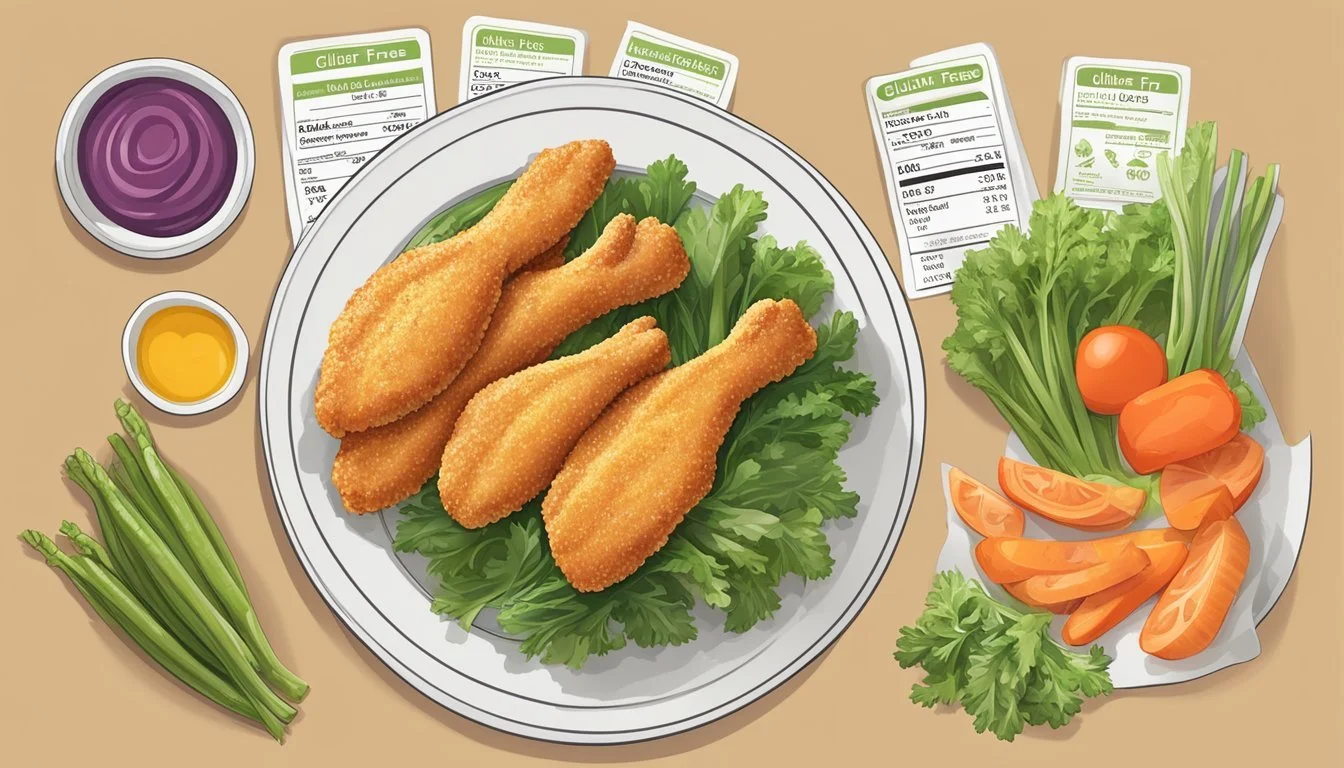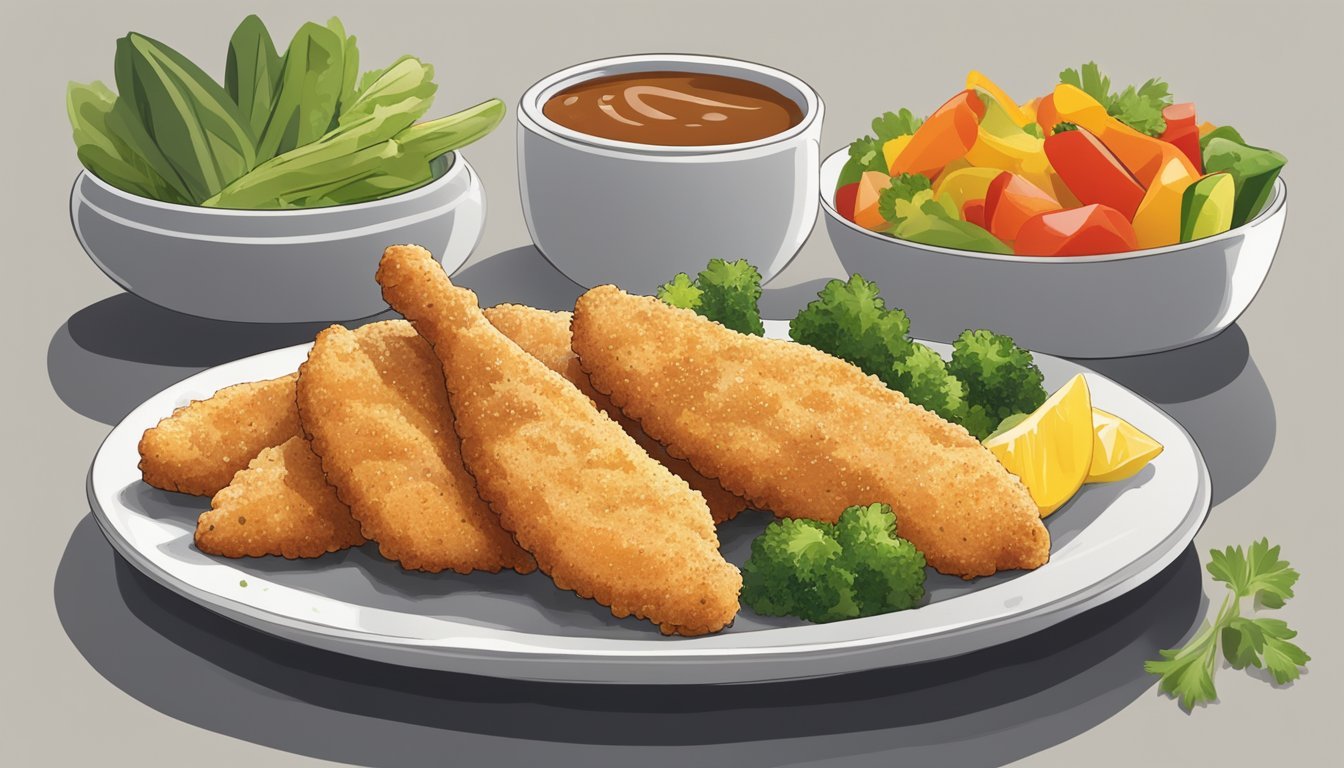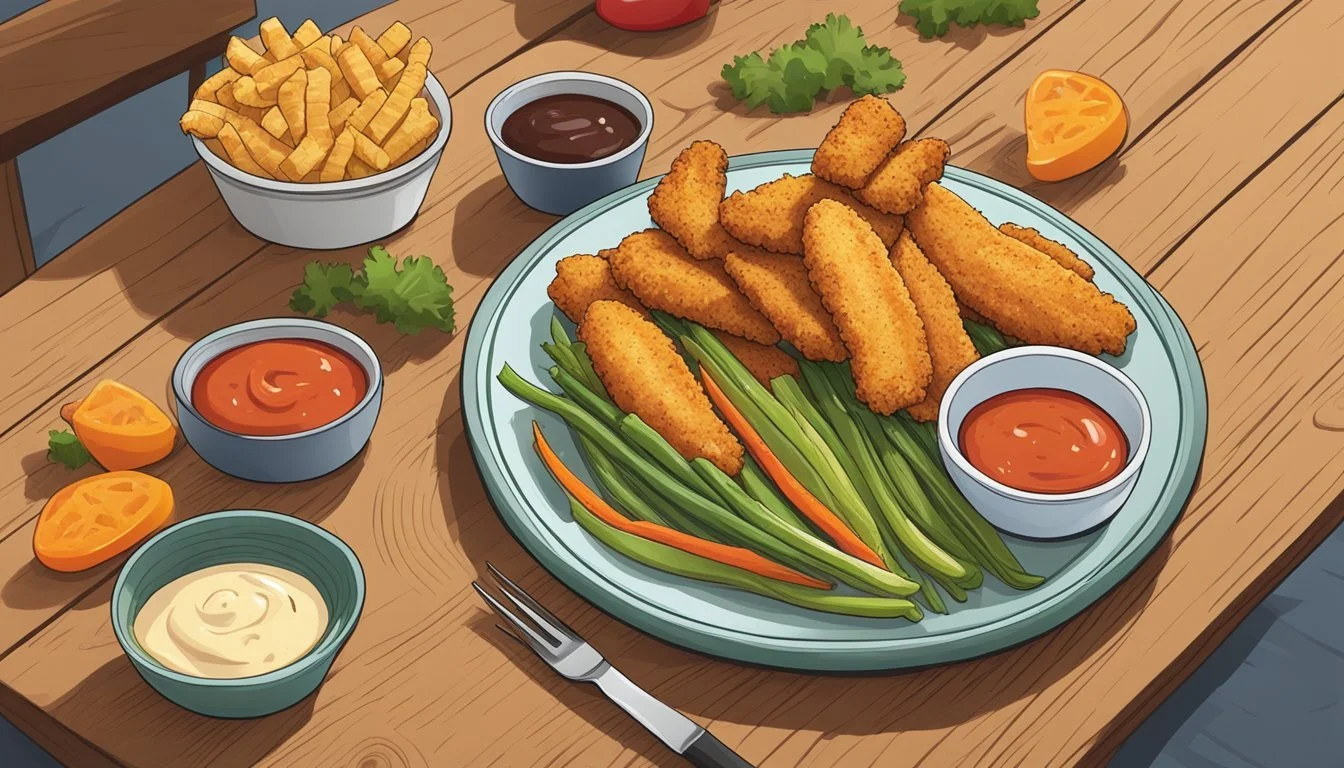How Long Does Gluten-Free Chicken Tenders Last?
Storage Tips and Shelf Life
When considering how long gluten-free chicken tenders last, key factors such as ingredients, storage methods, and whether they are homemade or store-bought come into play. Properly stored gluten-free chicken tenders can typically last in the refrigerator for up to 3-4 days. If frozen, these tenders can extend their shelf life to about 1-2 months, retaining their taste and texture well when reheated.
Homemade gluten-free chicken tenders, prepared with fresh ingredients, should be stored in an airtight container to maintain their quality. Crucial elements like the type of coating and the freshness of the chicken impact their longevity. Many recipes suggest using breadcrumbs or a mixture of tapioca starch and spices to ensure a crisp texture even after storage.
For those who prefer store-bought options, refer to the manufacturer’s guidelines on the packaging. These tenders often contain preservatives which can extend shelf life but should still be consumed within recommended time frames to ensure safety and enjoy their best flavor. Regularly checking the expiration date and storing them correctly can help in maximizing their freshness.
Understanding Gluten-Free Chicken Tenders
Gluten-free chicken tenders have become popular for those with gluten sensitivities or celiac disease. This review explains the significance of gluten-free diets and provides an overview of chicken tenders.
Define Gluten-Free and Its Importance
A gluten-free diet eliminates gluten, a protein found in wheat, barley, and rye. Gluten can cause severe reactions in individuals with celiac disease or non-celiac gluten sensitivity. Consuming gluten-free foods helps avoid symptoms like abdominal pain, bloating, and malnutrition.
Gluten-free chicken tenders cater to these dietary needs. They are made using gluten-free flours and breading, ensuring safety for those with gluten-related disorders. Additionally, gluten-free products often include healthier ingredients, promoting a balanced diet rich in protein, fiber, and necessary vitamins.
Overview of Chicken Tenders
Chicken tenders are strips of meat typically cut from the chicken breast. They are known for their tender texture and versatility in cooking methods such as frying, baking, or grilling. The preparation involves dipping these strips in a mixture of spices, flour, and breadcrumbs to create a crispy exterior while maintaining a juicy interior.
When prepared gluten-free, the flour and breadcrumbs are substituted with gluten-free alternatives like rice flour, chickpea flour, or gluten-free panko breadcrumbs. This ensures that the tenders remain protein-rich and safe for those avoiding gluten. Efficient marination and coating enhance their flavor, making gluten-free chicken tenders a delightful and healthy protein choice for many.
Ingredients and Substitutions
For well-prepared gluten-free chicken tenders, selecting fresh and high-quality ingredients is crucial. Various options for breading, seasonings, and flavor enhancers can elevate the dish significantly.
Selecting the Right Chicken
When choosing chicken, opt for boneless, skinless chicken breasts. They provide a lean and tender cut that is perfect for tenders. Trim any fat or gristle from the chicken breasts to ensure a clean and easy-to-coat strip. Cutting the chicken into evenly sized strips, about 4 inches long and 3/4 inch wide, helps achieve consistent cooking and texture.
Gluten-Free Breading Options
Breading plays a vital role in the texture of chicken tenders. Traditional options include gluten-free panko breadcrumbs, which offer a crispy exterior. Other alternatives are almond flour or gluten-free flour, which can be used independently or in combination to create varied textures.
Consider using these options individually or combined for different textures:
Gluten-free panko breadcrumbs: Crispy and light
Almond flour: Nutty and rich
Gluten-free flour: Versatile and easy to coat
Seasonings and Flavor Enhancers
Seasonings infuse the chicken tenders with flavor. A mix of salt, black pepper, paprika, garlic powder, and onion powder forms a robust base. Adjust the amounts according to taste preferences.
For extra depth, explore adding dried thyme or dried oregano to the breading mix. These herbs complement the chicken and create a well-rounded flavor profile. Marinating the chicken briefly in a mix of mayonnaise and seasonings can also enhance juiciness and flavor retention during cooking.
Preparation Techniques
Preparing gluten-free chicken tenders involves a few key steps: creating the breading mixture, coating the chicken, and prepping for the cooking process. Each step contributes to the final product's crispiness and taste.
Creating the Breading Mixture
Start with simple ingredients to ensure a flavorful and gluten-free breading mixture. Combine gluten-free flour, cornstarch, and seasonings in a bowl. Typical seasonings might include salt, pepper, garlic powder, and paprika.
Next, prepare a separate bowl for an egg mixture. Whisk together eggs and a bit of milk or water until smooth. This will help the breading adhere to the chicken.
Having separate bowls for the dry and wet ingredients helps streamline the prep process.
Breading and Coating the Chicken
To coat the chicken tenders, first dip each piece into the egg mixture. Ensure the chicken is fully covered in the egg to help the breading stick.
Next, roll the chicken in the flour mixture, pressing gently to create an even coating. Repeat the process for all chicken pieces, ensuring a uniform coating.
A double-dipping method can add extra crunch. After the first coating, dip the chicken back into the egg mixture and then again into the flour mixture.
Prepping for the Cooking Process
Before cooking, let the breaded chicken sit for a few minutes. This allows the coating to adhere better.
Preheat your oven or skillet to the appropriate temperature. For baking, line a sheet with parchment paper and place the chicken tenders on it. If frying, heat the oil in a skillet until it's shimmering.
Arrange the tenders without overcrowding them to ensure even cooking.
Cook according to your chosen method, turning as needed to achieve a crispy, golden coating. Use a meat thermometer to check for an internal temperature of 165°F (75°C) to ensure the chicken is cooked through.
Cooking Methods
When preparing gluten-free chicken tenders, there are multiple cooking methods available. Baking, frying, and using an air fryer each offer unique benefits and results.
Baking Gluten-Free Chicken Tenders
Baking gluten-free chicken tenders is a popular method for a healthier option without sacrificing flavor.
Preheat the oven to 400°F (200°C). Place the tenders on a baking sheet lined with parchment paper. Bake for 20-25 minutes, flipping halfway. Ensure the internal temperature reaches 165°F (74°C) using a thermometer for perfectly cooked tenders.
This method results in crispy tenders with a golden-brown exterior, and it avoids the extra fat associated with frying.
Frying Techniques for a Crispy Texture
For the crispiest gluten-free chicken tenders, frying is an excellent choice.
Use a high-smoke-point oil, such as canola or peanut oil. Heat the oil in a deep fryer or large pot to 350°F (175°C). Fry the tenders in small batches for 3-5 minutes each, ensuring they are golden brown and crispy.
Check the internal temperature with a thermometer to ensure it reaches 165°F (74°C). This method gives the tenders a crunchy texture that's hard to beat.
Using an Air Fryer for Healthier Options
An air fryer provides a healthier alternative while still achieving a crisp texture.
Preheat the air fryer to 375°F (190°C). Place the tenders in a single layer in the air fryer basket. Cook for 10-12 minutes, flipping halfway through.
Ensure the internal temperature reaches 165°F (74°C). This method requires less oil, making it a lighter option without compromising on crunchiness.
Nutritional Profile
Gluten-free chicken tenders offer a delicious and healthy option for those avoiding gluten. They can be made using a variety of coatings and methods, such as baking or air frying, which contributes to their nutritional value.
A serving of gluten-free chicken tenders typically contains around 200 to 250 calories. This can vary depending on the specific ingredients and cooking method used.
Macronutrients
Protein: Chicken tenders are a good source of protein. A serving provides approximately 20 grams of protein.
Fat: The fat content can range from 5 to 10 grams per serving, largely dependent on whether they are baked or fried and the type of coating used.
Carbohydrates: Gluten-free coatings tend to be made from ingredients like rice flour or cornmeal. A serving may contain 15 to 20 grams of carbohydrates.
Fiber and Sugar
Fiber: Depending on the coating, fiber content may be around 1 to 2 grams per serving.
Sugar: Gluten-free tenders usually have low sugar content, often less than 1 gram per serving.
Nutritional Ingredients
Gluten-free chicken tenders often include a blend of ingredients for flavor and texture such as spices, onion powder, garlic powder, and paprika. These not only enhance taste but also provide additional micronutrients that may contribute to overall health.
Maintaining a balanced intake of these macronutrients is essential for a healthy diet, making gluten-free chicken tenders a viable protein source especially tailored for those with gluten sensitivities.
Storing and Shelf Life
Proper storage is essential for maintaining the freshness and safety of gluten-free chicken tenders. Correctly refrigerating or freezing your tenders will extend their shelf life, ensuring they are both tasty and safe to eat.
Refrigeration and Freshness
After cooking, gluten-free chicken tenders should be cooled to room temperature before refrigerating. Store them in an airtight container or wrap them tightly in aluminum foil or plastic wrap. It is crucial to label the container with the date to track freshness.
In the refrigerator, gluten-free chicken tenders will generally last 3 to 4 days. Keep the refrigerator temperature at or below 40°F (4°C) to ensure optimal storage conditions. Always check for signs of spoilage, such as unusual odors or discoloration, before consuming.
Properly storing them in the refrigerator maintains not only the flavor but also the safe consumption of chicken tenders.
Freezing and Reheating Tips
Freezing gluten-free chicken tenders can extend their shelf life by several months. Place the tenders in a single layer on a baking sheet and freeze for 1-2 hours to prevent them from sticking together. Then, transfer them to a heavy-duty freezer bag or an airtight container.
Label the packaging with the date and store the tenders at 0°F (-18°C) or lower. Frozen chicken tenders can last up to 3 months if stored properly.
To reheat, it’s best to thaw them overnight in the refrigerator before baking or air frying to ensure even heating. For a crisp texture, reheating in an oven preheated to 400°F (200°C) for about 20 minutes or in an air fryer works well. Avoid microwaving as it may result in soggy tenders.
Serving Suggestions
Gluten-free chicken tenders can be enjoyed in a variety of ways. They pair perfectly with several sauces and sides, and they can be incorporated into numerous meals and salads.
Pairing with Sauces and Sides
Gluten-free chicken tenders are versatile and complement a range of dipping sauces. Honey mustard, ketchup, and sriracha mayo are popular choices. Each provides a unique flavor profile that enhances the tenders.
Mayonnaise-based sauces like garlic aioli can add a creamy richness. Classic barbecue sauce offers a smoky touch, while a rightly spiced buffalo sauce can introduce some heat. Sides such as fries, coleslaw, and steamed veggies make for a balanced meal.
Carrot sticks, celery, and a mix of fresh greens can add a crunchy, refreshing contrast to the crispy tenders.
Incorporating Into Meals and Salads
Gluten-free chicken tenders can elevate various meals. They work well in wraps, providing a hearty filling when combined with lettuce, tomatoes, and avocado.
Another idea is adding them to salad bowls. For example, a mix of greens, cherry tomatoes, cucumbers, and red onions can be topped with sliced chicken tenders for a protein-packed dish.
For a simple meal, serve the tenders over rice or quinoa , integrating vegetables within for color and nutrition. Integrating tenders into pasta dishes, such as a gluten-free chicken Alfredo, can also be a delightful way to enjoy them.
Tips for Perfect Gluten-Free Chicken Tenders
Achieving the ideal gluten-free chicken tender involves paying attention to key details like avoiding common mistakes and ensuring the tenders remain crispy and flavorful throughout the cooking process.
Avoiding Common Mistakes
Always ensure the chicken is cut into uniform pieces. This promotes even cooking. When preparing the batter, thoroughly whisk the ingredients to avoid clumps that can lead to uneven coating.
Do not overcrowd the baking sheet or frying pan. Overcrowding lowers the cooking temperature, resulting in less crispy tenders. Spread the chicken in a single layer, ideally using a wire rack for even air circulation.
Use tongs when handling the chicken to prevent scratching off the coating. This also helps maintain the texture and structure of the tenders.
Ensuring Crispiness and Flavor
Marinate your chicken tenders in buttermilk or a spice blend for at least an hour. This step not only tenderizes the meat but also infuses it with flavor.
Coat them thoroughly with gluten-free breadcrumbs or panko for a crunchy exterior. When baking, spritz the tenders with a light coat of oil to enhance crispiness without frying.
Season generously with your favorite spices. Common additions include salt, pepper, garlic powder, and paprika. For those who prefer spicy tenders, consider adding a pinch of cayenne pepper or chili flakes to the breadcrumb mixture.
Flip halfway through the cooking process using tongs to ensure both sides are evenly cooked and crispy.
Avoid wrapping the tenders tightly in foil when cooling or storing, as this can cause the coating to become soggy. Instead, place them on a wire rack to maintain their crispy texture.
By following these tips, one can achieve perfectly cooked gluten-free chicken tenders every time.
Alternative Gluten-Free Protein Options
For those seeking a variety of protein options while maintaining a gluten-free diet, several delicious alternatives are available.
Gluten-Free Chicken Nuggets can be homemade using gluten-free breadcrumbs or panko. These nuggets provide the familiar taste and texture of traditional chicken nuggets without gluten. Pair them with your favorite dipping sauces for added flavor.
Orange Chicken offers a tangy and savory profile. To keep this dish gluten-free, use gluten-free soy sauce and cornstarch for the batter. This dish is perfect for a flavorful meal that doesn't compromise dietary restrictions.
Chicken Salad is another versatile and easy-to-make option. Combine diced or shredded chicken with a mix of fresh vegetables and gluten-free dressings. This protein-rich dish can be served on its own or with gluten-free bread or crackers.
Fried Chicken can be enjoyed gluten-free by using alternative flours like rice flour, cornstarch, or a blend of gluten-free flours for the coating. Ensure the oil is hot enough to give the chicken a crispy exterior while keeping it juicy inside.
Consider exploring a variety of recipes and ingredients to keep your meals diverse and satisfying.










